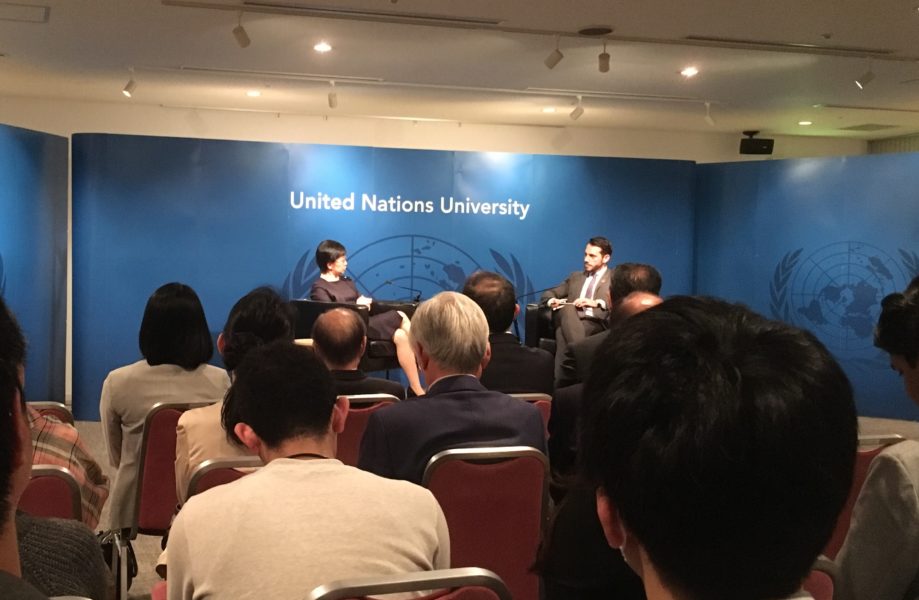The so-called “great powers” are not so great when it comes to nuclear disarmament. Forty-nine years ago they entered into a legally binding commitment, known as the Nuclear Non-Proliferation Treaty (NPT), to “pursue negotiations in good faith … on a treaty on general and complete disarmament under strict and effective international control.” It’s hard to argue, though the great powers try to do so, that spending trillions to maintain and modernize their nuclear arsenals is an act of good faith.
Optimism in the face of that kind of hypocrisy can be hard to find, but it made an appearance this week on the campus of the United Nations University in Tokyo. Ms. Izumi Nakamitsu, the UN High Representative for Disarmament Affairs, spoke convincingly to a conference room packed with concerned academics, students and activists about improving prospects for progress in nuclear disarmament.

April 23, 2019: UN Undersecretary General Nakamitsu discusses disarmament at the United Nations University in Tokyo. G. Kulacki/UCS
International Norms Still Matter
One prerequisite for progress is a high level of commitment among UN member states to international law and organization. Nakamitsu said that although politicians from the United States and other nations are mobilizing nationalist resentments against the accelerating social and economic developments knitting the planet together, public officials in the rest of the world are responding with “a renewed commitment to multilateralism.” She emphasized, repeatedly, that the United Nations cannot force the nuclear weapons states to disarm. But it can help create the conditions for progress.
An important bellwether is the NPT itself. The third meeting of the preparatory committee for the NPT review conference in 2020 is being held in New York. In advance of the meeting even President Trump, who revels in undermining the United Nations, is talking about the need for nuclear arms control. US Secretary of State Mike Pompeo opened the door to deep nuclear cuts by suggesting that the United States and Russia should join China, which has a small nuclear arsenal of several hundred weapons that it keeps off alert, in the negotiation of a new strategic arms limitation treaty. Despite these public statements–and time will tell if they are sincere–the Trump administration is asking Congress for new funds to rapidly modernize and expand the US nuclear arsenal. It also refused to endorse President Reagan’s statement that “A nuclear war cannot be won and should never be fought.” But even Trump and his assemblage of nuclear hawks feel the need to at least pretend, at a moment when the world is gathering to sure up the NPT, that international nuclear arms control is a solemn US obligation.
Looking Forward
Nakamitsu was enthusiastic about the new UN Agenda for Disarmament launched by UN Secretary General António Guterres last May. She reminded her audience the very first UN General Assembly resolution established the international community’s right and responsibility to “enquire into” and “make recommendations” that would lead to “the elimination from national armaments of atomic weapons.” She said one of the most exciting initiatives on the agenda is to engage new constituencies that can support the United Nations in the fulfillment of that mandate.
The most consequential may be the global scientific community, which is much larger, more diverse and more capable than it was in 1946. Nakamitsu spends a lot of time with scientific groups all over the world and notes that many scientists never thought about nuclear disarmament, much less how they might participate in the process. At first blush that may seem discouraging but it is actually a cause for hope. The global discussion of nuclear disarmament is currently dominated by a small clique of experts closely associated with the nuclear weapons states. Expanding that discussion to include more diverse and scientifically competent voices is a task ideally suited for the United Nations. Nakamitsu’s outreach is already leading to some interesting conversations.
For example, she recalled a meeting with IT engineers at a major global corporation where she sought advice on the potential impact of artificial intelligence on nuclear weapons command and control systems. The discussion started with a recitation of familiar concerns about machines deciding to launch nuclear weapons with no human oversight. But it ended with the speculation that it might be possible to encode all modern weapons systems with an algorithm that allowed the machines to understand, interpret and apply international humanitarian law. As I sat there listening to the undersecretary I imagined a pilot about to launch a missile strike getting a warning stating, “System analytics have determined your action will result in the commission of a war crime. This incident will be recorded and filed with the United Nations War Crimes Commission.”
This is just one of the many thought-provoking encounters Nakamitsu experienced after the new agenda was launched. She believes they’re creating greater global interest in advancing nuclear disarmament.
Power to the People
Finally, and perhaps most importantly, the undersecretary emphasized history suggests greater public engagement forces national decision-makers to pursue international nuclear arms control. She recalled the role of the Japanese women who helped ignite the worldwide public campaign that led to the signing of the 1963 Partial Test Ban Treaty (PTBT), which prohibited the testing of nuclear weapons in the atmosphere, outer space and under water.
The UN’s new disarmament agenda also calls for the unprecedented use of the offices and resources of the United Nations to reach out to women and other constituencies sidelined by the male-dominated conversations about nuclear disarmament that occur between officials and experts from the nuclear weapons states. Nakamitsu related her own efforts to engage much younger audiences, and patiently fielded questions from the students and educators who attended her presentation. She reminded the older members of the audience, like me, that while complete and total nuclear disbarment is unlikely to occur in our lifetimes, the hope for our future lies in engaging young people and arming them with the information they need to carry on the struggle.
